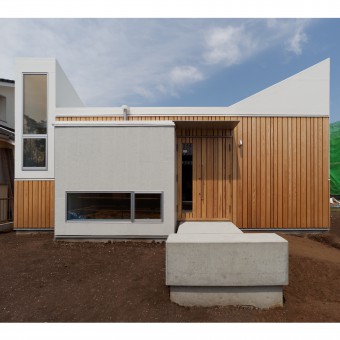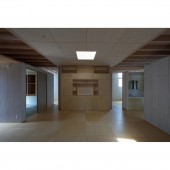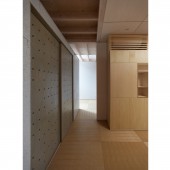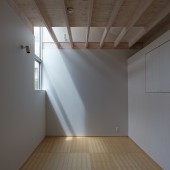
| THE AWARD |
| CATEGORIES |
| REGISTRATION |
| SUBMIT YOUR WORK |
| ENTRY INSTRUCTIONS |
| TERMS & CONDITIONS |
| PUBLICATIONS |
| DATES & FEES |
| METHODOLOGY |
| CONTACT |
| WINNERS |
| PRESS ROOM |
| GET INVOLVED |
| DESIGN PRIZE |
| DESIGN STORE |
| THE AWARD | JURY | CATEGORIES | REGISTRATION | PRESS | WINNERS | PUBLICATIONS | ENTRY INSTRUCTIONS |
Celestial Light Private Residence by Frank la Rivière |
Home > Winners > Design #52779 >Interview |
 |
|
FS: What is the main principle, idea and inspiration behind your design?
Fl: The main departing point for this design was to come to a solution that would give the client a residence with abundant natural light whilst being protective of privacy.
FS: What has been your main focus in designing this work? Especially what did you want to achieve?
Fl: This departing point led to the development of a plan with 4 large high side windows that are placed high in the façade and stick through the roof-line of the house. From these vertical windows the roof slants backwards to form daylight scoops that reflect light deep into the interior. Because the windows are placed high in the façade, casual passers-by cannot look into the interior, hence protecting the privacy.
FS: How long did it take you to design this particular concept?
Fl: It took a bit less than a year to complete this concept design. However, we often do quite a bit of extra detailing of the design during construction. This is quite usual in Japan.
FS: Why did you design this particular concept? Was this design commissioned or did you decide to pursuit an inspiration?
Fl: This particular house was commissioned by a client and the users are a family of 4, husband and wife with two young sons. They lived in a nearby apartment building and bought a site in the neighbourhood with the idea to build a one story private residence.
FS: What made you design this particular type of work?
Fl: In this case it was a commission for a private residence for a family of 4 as well as the site conditions and the planning restrictions that formed the starting point of this design. Additionally, the client’s ambitions and their trust in us as the architects to create out of all these parameters a comfortable and unique house was another driver of this project. By times it must seem mysterious what architects do when designing and it is all the more important for the quality of the final result to be trusted by the client throughout the design and construction process. Without this trust and mutual respect, it is difficult to come to a fruitful collaboration that results in a good building. We belief that this condition strongly existed in this case seen the quality of the house and the satisfaction of the client.
FS: Where there any other designs and/or designers that helped the influence the design of your work?
Fl: Working as a foreign architect in Japan for a Japanese client was an aspect that influenced the project. While not initially intended yet subliminally achieved, the plan reflects the tatami lay-out of the traditional tea ceremony roofs of 4,5 matts. This is an aspect that came into the project by working on the proportions and dimensioning, based on the Japanese material module of 910 x 1820 for wooden post and beam structures. In a similar way the two smaller boxes that stick out of the façade happen to be exactly the size of the 4,5 matt tearoom. This size happened to work well for these spaces. There is another aspect that refers to the Japanese design tradition. The dis-symmetry that is introduced by shifting the two small box spaces out of the centre creates a softening of the square geometry that could easily lead to a rigid symmetry. This is a design strategy that is often found in traditional Japanese design and that also forms an important aspect of our design approach to come to humane spaces.
FS: Who is the target customer for his design?
Fl: A family of 4, husband and wife with two young sons.
FS: What sets this design apart from other similar or resembling concepts?
Fl: The clarity of the concept with the particular placing and use of the 4 windows and the connection to the roof create the unusual form of the building. Most of the houses in the neighbourhood are constructed by home builders and look very standard and conventional. This house is both characteristic while purpose designed and responsive to the live style of the users.
FS: How did you come up with the name for this design? What does it mean?
Fl: The name of the project reflects the effect of the placement of the 4 windows in the façade on the light quality in the interior space. But it is also chosen to express the contact with the sky that could be seen as a contact with the holy, the eternal. In addition, the roof light in the centre of the house projects a beam of light, like the hand of god. The beam changes position like a sun dial.
FS: Which design tools did you use when you were working on this project?
Fl: We sketch a lot and make both physical and computer models to simulate the design interventions. This allows, for example, to check on forehand the effect of the daylight in the interior. We needed to be sure that the interior would be well lit with a comfortable level of light, while we were basically designing a fairly closed box with only 4 important windows for the main space.
FS: What is the most unique aspect of your design?
Fl: The most unique aspect of the design is most definitely the fact that the whole house is purpose designed and meticulously crafted by the carpenters. Hardly any off-the-shelf materials were used. When used, these materials were integrated into the design as not to be obvious. All was made to fit the design of this house and therefore it has a great harmony. In other words, it is most definitely not a collage of standard building elements, as quite often happens in Japanese standard house construction, but completely purpose crafted.
FS: Who did you collaborate with for this design? Did you work with people with technical / specialized skills?
Fl: We always work with a structural engineer and a mechanical engineer to come to an appropriate technical solution for the support structure and the installation. In this case a great deal of the structure has a dominant visual role in the interior, where the roof rafters are designed in a pattern that corresponds to the zoning of the plan.
FS: What is the role of technology in this particular design?
Fl: Technique and aesthetics are like the two sides of the same coin. The techniques selected create the buildings stability, durability and comfort while the aesthetics knit the emotional dimension of all the means into a meaningful whole. The end result is thus way both a functional effective structure as well as an emotional affective entity.
FS: What are some of the challenges you faced during the design/realization of your concept?
Fl: There was a great contradiction to solve, provoked by the requirement of a well-lit interior while not exposing the inside to the outside world for privacy protection. But it is the solution to this challenge that makes the house. We feel that we have turned this contradiction into the most positive asset of the house.
FS: How did you decide to submit your design to an international design competition?
Fl: We felt confident that this design was successful in responding to all the parameters of the assignment and that the result reflected our design ability in a way that would hopefully be recognised in an international design competition like this one, in spite of the fact that it is rather small and had to be done with a small budget.
FS: What did you learn or how did you improve yourself during the designing of this work?
Fl: All our projects are achieved through a process that constitutes both a reworking of previous attained experiences and updating them through research of new materials, construction methods and design elements. This in itself is always a great learning experience that will form the base for projects to come.
FS: Any other things you would like to cover that have not been covered in these questions?
Fl: We feel that the trust and mutual respect between all parties involved in the design and construction of buildings and in particular this house is the prerequisite for achieving good architecture. The condition under which this house was achieved couldn’t have been better. We are very grateful for this and feel that this award is in recognition of this process reflected in its result.
FS: Thank you for providing us with this opportunity to interview you.
A' Design Award and Competitions grants rights to press members and bloggers to use parts of this interview. This interview is provided as it is; DesignPRWire and A' Design Award and Competitions cannot be held responsible for the answers given by participating designers.
| SOCIAL |
| + Add to Likes / Favorites | Send to My Email | Comment | View Press-Release |





